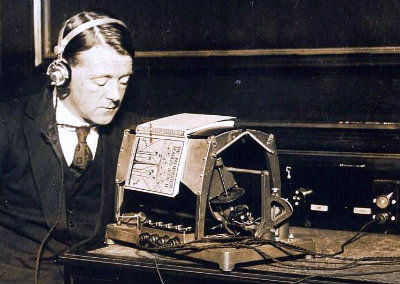I love looking at early technology and seeing how people problem-solve

Back in the early 80's, I remember our sixth-grade teacher taking us to see a 'new wonder device' – a Kurzweil reading machine.
It wasn't exactly a sexy design. It looked like a photocopier but was closer to the size of a family washing machine. You placed an open book on the top and it read aloud, even turning pages when required. The voice synthesizer was a little harsh on the ear but, hey, it was 1981 and this thing spoke better english than R2-D2, so it was hard to be super-critical.
We all thought it was very cool – but also wet-your-pants hilarious when the machine attempted to 'read' illustrations as text. "Period,… tee, …. owe, owe, period…. hyphen, … hyphen, owe.., jay, owe".
It was funny. Trust me.
These machines were a really big deal at the time. Walter Cronkite once used one to sign off from his national TV news show and Stevie Wonder adored his. It's easy to forget that reading privacy is an everyday luxury that visually-challenged users lose. This invention gave that back.
So, Was This the First Reading Machine?
Not quite.

This is the Optophone, a reading machine that was invented just before the First World War – in 1913.
How is that even possible, right?
This is before television, transistors, vacuum tubes – planes still look like jumped-up kites. It's hard to even contemplate tackling this challenge at a time when electricity in the home was still a novelty.
But someone did. His name was Edmund Edward Fournier d'Albe and he was an Irish physicist, inventor, and all-round renaissance guy.
How did the Optophone work?

Like Kurzweil's machine, readers placed the book on the glass top and the reading head below rocked from side-to-side, playing audio to the user through a headset.
Fournier d'Albe's invention relied on using selenium cells to turn reflected light from the page into different musical tones.
Users would learn to associate particular sounds with letters, and construct words and sentences that way.
It certainly wasn't a perfect system. Even the most skilled blind users only achieved reading speeds of around 60 words per minute. Most sighted readers hum along at closer to 300. Still, it sure beats zero.
But perhaps the biggest hurdle for users was the so-called 'music' it produced. Unfortunately, the tones it made were teeth-jarringly awful.
Don't believe me? We can still listen to them today on this SoundCloud recording.
Continue reading %Stevie Wonder and the Rise of the Machine Readers%
Source: SitePoint
